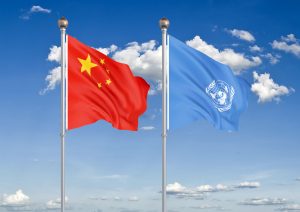At the end of a large-scale military exercise held in response to U.S. House Speaker Nancy Pelosi’s visit to Taiwan, the government of the People’s Republic of China (PRC) released a new white paper on its policy toward Taiwan. The white paper, entitled “The Taiwan Question and China’s Reunification in the New Era,” is the first white paper on Taiwan affairs in 22 years, following “The Taiwan Issue and Chinese Reunification” (1993) and “The One-China Principle and the Taiwan Issue” (2000). The new white paper reviews Xi Jinping’s policy toward Taiwan since the Chinese Communist Party’s 18th Party Congress in 2012 and reasserts its rationale and assumptions.
In the new white paper, the PRC government’s discussions of international support for the One China principle has significantly changed from the past two papers. The new white paper devotes a great deal of space to explaining the United Nations General Assembly Resolution 2758 (hereafter Resolution 2758), which it cites as the basis for its claim that the One China principle is widely accepted in the present international community.
Resolution 2758 was adopted by the 26th U.N. General Assembly in October 1971 that solved the issue of China’s U.N. representation. With the adoption of this resolution, the PRC was recognized as the “only lawful representative of China” and “one of the five permanent members of the Security Council.” The resolution also served to “expel forthwith the representatives of Chiang Kai-shek,” and the representatives of the Republic of China (ROC) government on Taiwan left the floor in protest. However, there is nothing more to Resolution 2758 than that. In other words, the core assertion of Beijing’s One China principle, “Taiwan is part of the PRC,” is nowhere to be found. In fact, the word “Taiwan” is not even mentioned in the resolution; nor is the ROC.
Why does the PRC government now emphasize Resolution 2758 as the basis for its One China principle? Although there were references to Resolution 2758 in the past two white papers, there is no statement that goes beyond the factual background described above. It has been speculated that Beijing must rely on Resolution 2758 amid a sense of crisis that the series of partial agreements on “One China” with the United States, Japan, and other countries now exist mostly in name only. In fact, in the new white paper, the number of references to the agreement on “One China” with the U.S. and other countries has decreased significantly, in contrast to the increase in references to Resolution 2758.
How can Resolution 2758 be an argument for the One China principle? Since the late 1990s, China has been engaged in activities in the U.N. system to promote the de facto recognition that “Taiwan is part of the PRC” and has had some success in this endeavor. The new white paper emphasizes that “it was clearly stated in the official legal opinions of the Office of Legal Affairs of the U.N. Secretariat that the U.N. considers ‘Taiwan’ as a province of China with no separate status,” and “at the U.N. the island is referred to as ‘Taiwan, Province of China.”
The basis for this argument was the legal opinion of the U.N. Secretariat issued when a member state used the title “Republic of China (Taiwan)” in a national report submitted under the Universal Periodic Mechanism of the Human Rights Council, and another member state – presumably China – protested this as a violation of Resolution 2758. At that time, the Secretariat did not allow unilateral correction of each country’s report. Still, it stated clearly that “since the adoption of that resolution the U.N. considers ‘Taiwan’ as a province of China with no separate status, and the Secretariat strictly abides by this decision in the exercise of its responsibilities.” This statement goes beyond the original implication of Resolution 2758, but this is not the only case in which the U.N. organizations have rewritten their designations and conventions regarding Taiwan at the instigation of the PRC.
A report released by the German Marshall Fund in March of this year, “Distortions of Resolution 2758 Restricting Taiwan’s Access to the United Nations,” examined how the PRC has worked to infiltrate the logic that Resolution 2758 is an acceptance of the “One China” principle into the U.N. system. The report then recommends that the U.S. and like-minded countries work together to express opposition to the PRC’s attempt to distort the meaning of Resolution 2758, to press the International Organization for Standardization (ISO) to reverse its decision to use “Taiwan, Province of China,” and request the U.N. to release information on China’s influence operations in the U.N. system.
Resolution 2758 is emphasized in the new white paper as the basis for the “One China” principle throughout the international community. This has made diplomatic efforts such as those recommended by the German Marshall Fund even more necessary. If this issue is ignored, it will lead to the PRC using its influence at the U.N. on other contentious issues to push through unjustified claims and force changes in the existing international order.

































